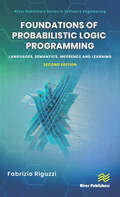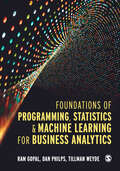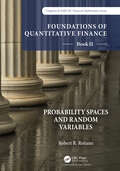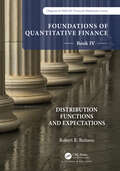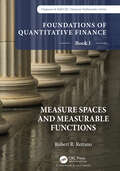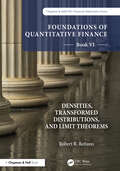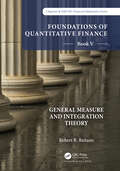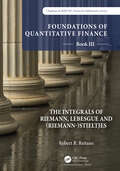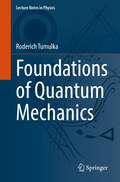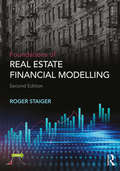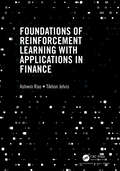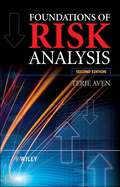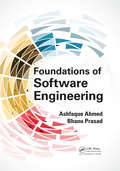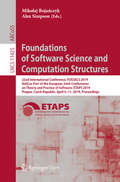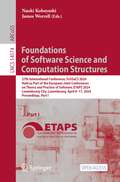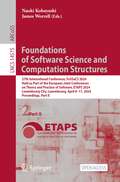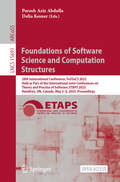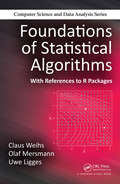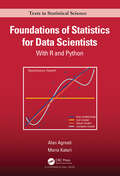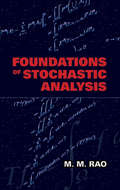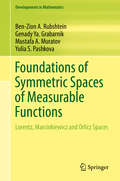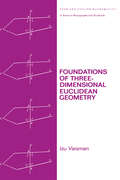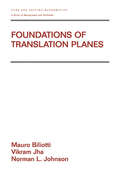- Table View
- List View
Foundations of Probabilistic Logic Programming: Languages, Semantics, Inference and Learning
by Fabrizio RiguzziSince its birth, the field of Probabilistic Logic Programming has seen a steady increase of activity, with many proposals for languages and algorithms for inference and learning. This book aims at providing an overview of the field with a special emphasis on languages under the Distribution Semantics, one of the most influential approaches. The book presents the main ideas for semantics, inference, and learning and highlights connections between the methods. Many examples of the book include a link to a page of the web application http://cplint.eu where the code can be run online. This 2nd edition aims at reporting the most exciting novelties in the field since the publication of the 1st edition. The semantics for hybrid programs with function symbols was placed on a sound footing. Probabilistic Answer Set Programming gained a lot of interest together with the studies on the complexity of inference. Algorithms for solving the MPE and MAP tasks are now available. Inference for hybrid programs has changed dramatically with the introduction of Weighted Model Integration. With respect to learning, the first approaches for neuro-symbolic integration have appeared together with algorithms for learning the structure for hybrid programs. Moreover, given the cost of learning PLPs, various works proposed language restrictions to speed up learning and improve its scaling.
Foundations of Programming, Statistics, and Machine Learning for Business Analytics
by Ram Gopal Dan Philps Tillman WeydeBusiness Analysts and Data Scientists are in huge demand, as global companies seek to digitally transform themselves and leverage their data resources to realize competitive advantage. This book covers all the fundamentals, from statistics to programming to business applications, to equip you with the solid foundational knowledge needed to progress in business analytics. Assuming no prior knowledge of programming or statistics, this book takes a simple step-by-step approach which makes potentially intimidating topics easy to understand, by keeping Maths to a minimum and including examples of business analytics in practice. Key features: · Introduces programming fundamentals using R and Python · Covers data structures, data management and manipulation and data visualization · Includes interactive coding notebooks so that you can build up your programming skills progressively Suitable as an essential text for undergraduate and postgraduate students studying Business Analytics or as pre-reading for students studying Data Science. Ram Gopal is Pro-Dean and Professor of Information Systems at the University of Warwick. Daniel Philps is an Artificial Intelligence Researcher and Head of Rothko Investment Strategies. Tillman Weyde is Senior Lecturer at City, University of London.
Foundations of Psychological Testing
by Leslie A. Miller Robert L. Lovler Sandra A. McintireAuthors Sandra McIntire and Leslie Miller have accomplished what few before them have been able to. They have written a Psychological Testing book that is designed to lay a true foundation for learning and understanding. The primary objective of this text is not to dwell on the details of individual psychological tests, but to focus on the core concepts/psychometrics required to gain an appreciation of how to use the tests properly. Written in response to a growing need for a textbook on psychological testing conducive to maximal student learning, An Introduction Psychological Testing, gives students an understanding of the basic concepts, issues and tools used in psychological testing. It then effectively illustrates how these concepts, issues, and tools are relevant to them in everyday educational, clinical, and organizational settings.
Foundations of Quantitative Finance Book II: Probability Spaces and Random Variables
by Robert R. ReitanoEvery financial professional wants and needs an advantage. A firm foundation in advanced mathematics can translate into dramatic advantages to professionals willing to obtain it. Many are not—and that is the advantage these books offer the astute reader. Published under the collective title of Foundations of Quantitative Finance, this set of ten books presents the advanced mathematics finance professionals need to advantage their careers, these books present the theory most do not learn in graduate finance programs, or in most financial mathematics undergraduate and graduate courses. As a high-level industry executive and authoritative instructor, Robert R. Reitano presents the mathematical theories he encountered in nearly three decades working in the financial industry and two decades teaching in highly respected graduate programs. Readers should be quantitatively literate and familiar with the developments in the first book in the set, Foundations of Quantitative Finance Book I: Measure Spaces and Measurable Functions.
Foundations of Quantitative Finance Book IV: Distribution Functions and Expectations (Chapman and Hall/CRC Financial Mathematics Series)
by Robert R. ReitanoEvery finance professional wants and needs a competitive edge. A firm foundation in advanced mathematics can translate into dramatic advantages to professionals willing to obtain it. Many are not—and that is the competitive edge these books offer the astute reader. Published under the collective title of Foundations of Quantitative Finance, this set of ten books develops the advanced topics in mathematics that finance professionals need to advance their careers. These books expand the theory most do not learn in graduate finance programs, or in most financial mathematics undergraduate and graduate courses. As an investment executive and authoritative instructor, Robert R. Reitano presents the mathematical theories he encountered and used in nearly three decades in the financial services industry and two decades in academia where he taught in highly respected graduate programs. Readers should be quantitatively literate and familiar with the developments in the earlier books in the set. While the set offers a continuous progression through these topics, each title can be studied independently. Features Extensively referenced to materials from earlier books Presents the theory needed to support advanced applications Supplements previous training in mathematics, with more detailed developments Built from the author's five decades of experience in industry, research, and teaching Published and forthcoming titles in the Robert R. Reitano Quantitative Finance Series: Book I: Measure Spaces and Measurable Functions Book II: Probability Spaces and Random Variables Book III: The Integrals of Lebesgue and (Riemann-)Stieltjes Book IV: Distribution Functions and Expectations Book V: General Measure and Integration Theory Book VI: Densities, Transformed Distributions, and Limit Theorems Book VII: Brownian Motion and Other Stochastic Processes Book VIII: Itô Integration and Stochastic Calculus 1 Book IX: Stochastic Calculus 2 and Stochastic Differential Equations Book X: Classical Models and Applications in Finance
Foundations of Quantitative Finance, Book I: Measure Spaces and Measurable Functions
by Robert R. ReitanoThis is the first in a set of 10 books written for professionals in quantitative finance. These books fill the gap between informal mathematical developments found in introductory materials, and more advanced treatments that summarize without formally developing the important foundational results professionals need. Book I in the Foundations in Quantitative Finance Series develops topics in measure spaces and measurable functions and lays the foundation for subsequent volumes. Lebesgue and then Borel measure theory are developed on ℝ, motivating the general extension theory of measure spaces that follows. This general theory is applied to finite product measure spaces, Borel measures on ℝn, and infinite dimensional product probability spaces. The overriding goal of these books is a complete and detailed development of the many mathematical theories and results one finds in popular resources in finance and quantitative finance. Each book is dedicated to a specific area of mathematics or probability theory, with applications to finance that are relevant to the needs of professionals. Practitioners, academic researchers, and students will find these books valuable to their career development. All ten volumes are extensively self-referenced. The reader can enter the collection at any point or topic of interest, and then work backward to identify and fill in needed details. This approach also works for a course or self-study on a given volume, with earlier books used for reference. Advanced quantitative finance books typically develop materials with an eye to comprehensiveness in the given subject matter, yet not with an eye toward efficiently curating and developing the theories needed for applications in quantitative finance. This book and series of volumes fill this need.
Foundations of Quantitative Finance, Book VI: Densities, Transformed Distributions, and Limit Theorems (Chapman and Hall/CRC Financial Mathematics Series)
by Robert R. ReitanoEvery finance professional wants and needs a competitive edge. A firm foundation in advanced mathematics can translate into dramatic advantages to professionals willing to obtain it. Many are not—and that is the competitive edge these books offer the astute reader.Published under the collective title of Foundations of Quantitative Finance, this set of ten books develops the advanced topics in mathematics that finance professionals need to advance their careers. These books expand the theory most do not learn in graduate finance programs, or in most financial mathematics undergraduate and graduate courses.As an investment executive and authoritative instructor, Robert R. Reitano presents the mathematical theories he encountered and used in nearly three decades in the financial services industry and two decades in academia where he taught in highly respected graduate programs.Readers should be quantitatively literate and familiar with the developments in the earlier books in the set. While the set offers a continuous progression through these topics, each title can be studied independently.Features Extensively referenced to materials from earlier books Presents the theory needed to support advanced applications Supplements previous training in mathematics, with more detailed developments Built from the author's five decades of experience in industry, research, and teaching Published and forthcoming titles in the Robert R. Reitano Quantitative Finance Series:Book I: Measure Spaces and Measurable FunctionsBook II: Probability Spaces and Random VariablesBook III: The Integrals of Riemann, Lebesgue and (Riemann-)StieltjesBook IV: Distribution Functions and ExpectationsBook V: General Measure and Integration TheoryBook VI: Densities, Transformed Distributions, and Limit TheoremsBook VII: Brownian Motion and Other Stochastic ProcessesBook VIII: Itô Integration and Stochastic Calculus 1Book IX: Stochastic Calculus 2 and Stochastic Differential EquationsBook X: Classical Models and Applications in Finance
Foundations of Quantitative Finance: Book V General Measure and Integration Theory (Chapman and Hall/CRC Financial Mathematics Series)
by Robert R. ReitanoEvery finance professional wants and needs a competitive edge. A firm foundation in advanced mathematics can translate into dramatic advantages to professionals willing to obtain it. Many are not—and that is the competitive edge these books offer the astute reader.Published under the collective title of Foundations of Quantitative Finance, this set of ten books develops the advanced topics in mathematics that finance professionals need to advance their careers. These books expand the theory most do not learn in graduate finance programs, or in most financial mathematics undergraduate and graduate courses.As an investment executive and authoritative instructor, Robert R. Reitano presents the mathematical theories he encountered and used in nearly three decades in the financial services industry and two decades in academia where he taught in highly respected graduate programs.Readers should be quantitatively literate and familiar with the developments in the earlier books in the set. While the set offers a continuous progression through these topics, each title can be studied independently.Features Extensively referenced to materials from earlier books Presents the theory needed to support advanced applications Supplements previous training in mathematics, with more detailed developments Built from the author's five decades of experience in industry, research, and teaching Published and forthcoming titles in the Robert R. Reitano Quantitative Finance Series:Book I: Measure Spaces and Measurable FunctionsBook II: Probability Spaces and Random VariablesBook III: The Integrals of Lebesgue and (Riemann-)StieltjesBook IV: Distribution Functions and ExpectationsBook V: General Measure and Integration TheoryBook VI: Densities, Transformed Distributions, and Limit TheoremsBook VII: Brownian Motion and Other Stochastic ProcessesBook VIII: Itô Integration and Stochastic Calculus 1Book IX: Stochastic Calculus 2 and Stochastic Differential EquationsBook X: Classical Models and Applications in Finance
Foundations of Quantitative Finance: Book III. The Integrals of Riemann, Lebesgue and (Chapman & Hall/CRC Finance Series)
by Robert R. ReitanoEvery financial professional wants and needs an advantage. A firm foundation in advanced mathematics can translate into dramatic advantages to professionals willing to obtain it. Many are not—and that is the advantage these books offer the astute reader.Published under the collective title of Foundations of Quantitative Finance, this set of ten books presents the advanced mathematics finance professionals need to advance their careers. These books develop the theory most do not learn in Graduate Finance programs, or in most Financial Mathematics undergraduate and graduate courses.As an investment executive and authoritative instructor, Robert R. Reitano presents the mathematical theories he encountered and used in nearly three decades in the financial industry and two decades in education where he taught in highly respected graduate programs.Readers should be quantitatively literate and familiar with the developments in the first book in the set. While the set offers a continuous progression through these topics, each title can also be studied independently.Features Extensively referenced to utilize materials from earlier books Presents the theory needed to support advanced applications Supplements previous training in mathematics, with more detailed developments Built from the author's five decades of experience in industry, research, and teaching Published and forthcoming titles in the Robert R. Reitano Quantitative Finance Series:Book I: Measure Spaces and Measurable FunctionsBook II: Probability Spaces and Random VariablesBook III: The Integrals of Lebesgue and (Riemann-)StieltjesBook IV: Distribution Functions and ExpectationsBook V: General Measure and Integration TheoryBook VI: Densities, Transformed Distributions, and Limit Theorems Book VII: Brownian Motion and Other Stochastic ProcessesBook VIII: Itô Integration and Stochastic Calculus 1Book IX: Stochastic Calculus 2 and Stochastic Differential EquationsBook X: Classical Models and Applications in Finance
Foundations of Quantum Mechanics (Lecture Notes in Physics #1003)
by Roderich TumulkaThis book introduces and critically appraises the main proposals for how to understand quantum mechanics, namely the Copenhagen interpretation, spontaneous collapse, Bohmian mechanics, many-worlds, and others. The author makes clear what are the crucial problems, such as the measurement problem, related to the foundations of quantum mechanics and explains the key arguments like the Einstein-Podolsky-Rosen argument and Bell’s proof of nonlocality. He discusses and clarifies numerous topics that have puzzled the founding fathers of quantum mechanics and present-day students alike, such as the possibility of hidden variables, the collapse of the wave function, time-of-arrival measurements, explanations of the symmetrization postulate for identical particles, or the nature of spin. Several chapters are devoted to extending the different approaches to relativistic space-time and quantum field theory. The book is self-contained and is intended for graduate students and researchers who want to step into the fundamental aspects of quantum physics. Given its clarity, it is accessible also to advanced undergraduates and contains many exercises and examples to master the subject.
Foundations of Real Estate Financial Modelling
by Roger StaigerFoundations of Real Estate Financial Modelling, Second Edition is specifically designed to provide the scalable basis of pro forma modelling for real estate projects. The book introduces students and professionals to the basics of real estate finance theory prior to providing a step-by-step guide for financial real estate model construction using Excel. The book introduces an innovative new financial metric, P(Gain), which quantifies the probability of a Return of Capital and answers the most basic question for investing, "What is the probability I get my money back?".? This new second edition has been fully revised and expanded. The book is separated into three functional units: (1) Real Estate Valuation Basics, Theory and Skills, (2) Real Estate Pro Forma Modelling, (3) Real Estate Pro Forma (Enhancements). New and enhanced Chapters cover:? Interest rates Amortization Single- and multi-family unit Development module Rent roll module Waterfall (equity bifurcation) Hotel, retail/office and townhouse. ? In addition, this new edition includes problem sets and solutions at the end of each chapter as well as case studies underpinning the chapter topics. Further chapters are dedicated to risk quantification and include scenario, stochastic and Monte Carlo simulations, equity waterfalls, and adding U.S. GAAP financial statements to existing real estate pro forma models. This book is the ideal textbook for a Real Estate Finance class, providing the theoretical basis of real estate finance as well as valuable modelling skills for the workplace. This book provides individuals with a step-by-step instruction on how to construct a real estate financial model starting with a new spreadsheet. The resultant model is portable, scalable, and modular. A companion website provides the pro forma models to readers as a reference for their own constructed models.
Foundations of Reinforcement Learning with Applications in Finance
by Ashwin Rao Tikhon JelvisFoundations of Reinforcement Learning with Applications in Finance aims to demystify Reinforcement Learning, and to make it a practically useful tool for those studying and working in applied areas — especially finance. Reinforcement Learning is emerging as a powerful technique for solving a variety of complex problems across industries that involve Sequential Optimal Decisioning under Uncertainty. Its penetration in high-profile problems like self-driving cars, robotics, and strategy games points to a future where Reinforcement Learning algorithms will have decisioning abilities far superior to humans. But when it comes getting educated in this area, there seems to be a reluctance to jump right in, because Reinforcement Learning appears to have acquired a reputation for being mysterious and technically challenging. This book strives to impart a lucid and insightful understanding of the topic by emphasizing the foundational mathematics and implementing models and algorithms in well-designed Python code, along with robust coverage of several financial trading problems that can be solved with Reinforcement Learning. This book has been created after years of iterative experimentation on the pedagogy of these topics while being taught to university students as well as industry practitioners. Features Focus on the foundational theory underpinning Reinforcement Learning and software design of the corresponding models and algorithms Suitable as a primary text for courses in Reinforcement Learning, but also as supplementary reading for applied/financial mathematics, programming, and other related courses Suitable for a professional audience of quantitative analysts or data scientists Blends theory/mathematics, programming/algorithms and real-world financial nuances while always striving to maintain simplicity and to build intuitive understanding.
Foundations of Risk Analysis
by Terje AvenFoundations of Risk Analysis presents the issues core to risk analysis - understanding what risk means, expressing risk, building risk models, addressing uncertainty, and applying probability models to real problems. The author provides the readers with the knowledge and basic thinking they require to successfully manage risk and uncertainty to support decision making. This updated edition reflects recent developments on risk and uncertainty concepts, representations and treatment.New material in Foundations of Risk Analysis includes:An up to date presentation of how to understand, define and describe risk based on research carried out in recent years. A new definition of the concept of vulnerability consistent with the understanding of risk.Reflections on the need for seeing beyond probabilities to measure/describe uncertainties. A presentation and discussion of a method for assessing the importance of assumptions (uncertainty factors) in the background knowledge that the subjective probabilities are based on A brief introduction to approaches that produce interval (imprecise) probabilities instead of exact probabilities. In addition the new version provides a number of other improvements, for example, concerning the use of cost-benefit analyses and the As Low As Reasonably Practicable (ALARP) principle.Foundations of Risk Analysis provides a framework for understanding, conducting and using risk analysis suitable for advanced undergraduates, graduates, analysts and researchers from statistics, engineering, finance, medicine and the physical sciences, as well as for managers facing decision making problems involving risk and uncertainty.
Foundations of Soft Logic
by Oded Maimon Moshe KleinThis book presents a groundbreaking new mathematical paradigm and system (including inventing a new number) that enables a new approach to advancing the foundations of science and technology. The new approach allows connecting subjective and objective points of view that do not rely solely on the classical deductive approach. There is no need to fear paradoxical situations, because it’s precisely in them wherein lies the key to a new understanding that is more connected to life itself. This new model also serves to advance the theory of consciousness. Life is more colorful and diverse than just the binary colors of black and white. For this purpose, the authors propose a new type of number called Soft Number. The basic idea is to distinguish between the different multiples of the number zero. Soft Logic is a continuous extension of the idea of giving different meanings to the zero. The authors create a tangible model of an infinitely small world. This seemingly inconceivable world is important for understanding the essence of the connection between the external world of reality and the inner world of human beings and offers a new language to express it. This book systematically and axiomatically describes the mathematical development of Soft Logic and Soft Numbers and points to possible directions for scientific and technological applications. This book is a valuable resource for researchers working in mathematics, physics, biology, engineering, computer science and artificial intelligence as well as advanced-level students majoring in computer science, engineering and mathematics. Practitioners, Data Scientists, AI developers and readers interested in a scientific understanding of the concept of consciousness will also want to purchase this book.
Foundations of Software Engineering
by Ashfaque Ahmed Bhanu PrasadThe best way to learn software engineering is by understanding its core and peripheral areas. Foundations of Software Engineering provides in-depth coverage of the areas of software engineering that are essential for becoming proficient in the field. The book devotes a complete chapter to each of the core areas. Several peripheral areas are also explained by assigning a separate chapter to each of them. Rather than using UML or other formal notations, the content in this book is explained in easy-to-understand language. Basic programming knowledge using an object-oriented language is helpful to understand the material in this book. The knowledge gained from this book can be readily used in other relevant courses or in real-world software development environments.This textbook educates students in software engineering principles. It covers almost all facets of software engineering, including requirement engineering, system specifications, system modeling, system architecture, system implementation, and system testing. Emphasizing practical issues, such as feasibility studies, this book explains how to add and develop software requirements to evolve software systems.This book was written after receiving feedback from several professors and software engineers. What resulted is a textbook on software engineering that not only covers the theory of software engineering but also presents real-world insights to aid students in proper implementation. Students learn key concepts through carefully explained and illustrated theories, as well as concrete examples and a complete case study using Java. Source code is also available on the book’s website. The examples and case studies increase in complexity as the book progresses to help students build a practical understanding of the required theories and applications.
Foundations of Software Science and Computation Structures: 22nd International Conference, FOSSACS 2019, Held as Part of the European Joint Conferences on Theory and Practice of Software, ETAPS 2019, Prague, Czech Republic, April 6–11, 2019, Proceedings (Lecture Notes in Computer Science #11425)
by Mikołaj Bojańczyk Alex SimpsonThis open access book constitutes the proceedings of the 22nd International Conference on Foundations of Software Science and Computational Structures, FOSSACS 2019, which took place in Prague, Czech Republic, in April 2019, held as part of the European Joint Conference on Theory and Practice of Software, ETAPS 2019.The 29 papers presented in this volume were carefully reviewed and selected from 85 submissions. They deal with foundational research with a clear significance for software science.
Foundations of Software Science and Computation Structures: 27th International Conference, FoSSaCS 2024, Held as Part of the European Joint Conferences on Theory and Practice of Software, ETAPS 2024, Luxembourg City, Luxembourg, April 6–11, 2024, Proceedings, Part I (Lecture Notes in Computer Science #14574)
by James Worrell Naoki KobayashiThe two open access volumes LNCS 14574 and 14575 constitute the proceedings of the 27th International Conference on Foundations of Software Science and Computation Structures, FOSSACS 2024, which took place in Luxembourg in April 2024.The 24 full papers included in this book were carefully reviewed and selected from 79 submissions. They were organized in topical sections as follows: Part I: Infinite games; categorical semantics; automata and synthesis; Part II: Types and programming languages; logic and proofs; infinite-state systems.
Foundations of Software Science and Computation Structures: 27th International Conference, FoSSaCS 2024, Held as Part of the European Joint Conferences on Theory and Practice of Software, ETAPS 2024, Luxembourg City, Luxembourg, April 6–11, 2024, Proceedings, Part II (Lecture Notes in Computer Science #14575)
by James Worrell Naoki KobayashiThe two open access volumes LNCS 14574 and 14575 constitute the proceedings of the 27th International Conference on Foundations of Software Science and Computation Structures, FOSSACS 2024, which took place in Luxembourg in April 2024.The 24 full papers included in this book were carefully reviewed and selected from 79 submissions. They were organized in topical sections as follows: Part I: Infinite games; categorical semantics; automata and synthesis; Part II: Types and programming languages; logic and proofs; infinite-state systems.
Foundations of Software Science and Computation Structures: 28th International Conference, FoSSaCS 2025, Held as Part of the International Joint Conferences on Theory and Practice of Software, ETAPS 2025, Hamilton, ON, Canada, May 3–8, 2025, Proceedings (Lecture Notes in Computer Science #15691)
by Parosh Aziz Abdulla Delia KesnerThis open access book constitutes the proceedings of the 28th International Conference on Foundations of Software Science and Computation Structures, FOSSACS 2025, which took place in Hamilton, Canada, during May 2025, held as part of the International Joint Conferences on Theory and Practice of Software, ETAPS 2025. The 19 papers included in these proceedings were carefully reviewed and selected from 58 submissions. They focus on foundational research in software science on theories and methods to support the analysis, integration, synthesis, transformation, and verification of programs and software systems.
Foundations of Statistical Algorithms: With References to R Packages (Chapman & Hall/CRC Computer Science & Data Analysis)
by Claus Weihs Olaf Mersmann Uwe LiggesA new and refreshingly different approach to presenting the foundations of statistical algorithms, Foundations of Statistical Algorithms: With References to R Packages reviews the historical development of basic algorithms to illuminate the evolution of today's more powerful statistical algorithms. It emphasizes recurring themes in all statistical
Foundations of Statistics for Data Scientists: With R and Python (Chapman & Hall/CRC Texts in Statistical Science)
by Alan Agresti Maria KateriFoundations of Statistics for Data Scientists: With R and Python is designed as a textbook for a one- or two-term introduction to mathematical statistics for students training to become data scientists. It is an in-depth presentation of the topics in statistical science with which any data scientist should be familiar, including probability distributions, descriptive and inferential statistical methods, and linear modeling. The book assumes knowledge of basic calculus, so the presentation can focus on "why it works" as well as "how to do it." Compared to traditional "mathematical statistics" textbooks, however, the book has less emphasis on probability theory and more emphasis on using software to implement statistical methods and to conduct simulations to illustrate key concepts. All statistical analyses in the book use R software, with an appendix showing the same analyses with Python. The book also introduces modern topics that do not normally appear in mathematical statistics texts but are highly relevant for data scientists, such as Bayesian inference, generalized linear models for non-normal responses (e.g., logistic regression and Poisson loglinear models), and regularized model fitting. The nearly 500 exercises are grouped into "Data Analysis and Applications" and "Methods and Concepts." Appendices introduce R and Python and contain solutions for odd-numbered exercises. The book's website has expanded R, Python, and Matlab appendices and all data sets from the examples and exercises.
Foundations of Stochastic Analysis
by M. M. RaoStarting with the introduction of the basic Kolmogorov-Bochner existence theorem, this text explores conditional expectations and probabilities as well as projective and direct limits. Topics include several aspects of discrete martingale theory, including applications to ergodic theory, likelihood ratios, and the Gaussian dichotomy theorem. Numerous problems, most with hints. 1981 edition.
Foundations of Symmetric Spaces of Measurable Functions
by Ben-Zion A. Rubshtein Genady Ya. Grabarnik Mustafa A. Muratov Yulia S. PashkovaKey definitions and results in symmetric spaces, particularly Lp, Lorentz, Marcinkiewicz and Orlicz spaces are emphasized in this textbook. A comprehensive overview of the Lorentz, Marcinkiewicz and Orlicz spaces is presented based on concepts and results of symmetric spaces. Scientists and researchers will find the application of linear operators, ergodic theory, harmonic analysis and mathematical physics noteworthy and useful. This book is intended for graduate students and researchers in mathematics and may be used as a general reference for the theory of functions, measure theory, and functional analysis. This self-contained text is presented in four parts totaling seventeen chapters to correspond with a one-semester lecture course. Each of the four parts begins with an overview and is subsequently divided into chapters, each of which concludes with exercises and notes. A chapter called "Complements" is included at the end of the text as supplementary material to assist students with independent work.
Foundations of Three-Dimensional Euclidean Geometry
by Izu VaismanThis book presents to the reader a modern axiomatic construction of three-dimensional Euclidean geometry in a rigorous and accessible form. It is helpful for high school teachers who are interested in the modernization of the teaching of geometry.
Foundations of Translation Planes (Chapman & Hall/CRC Pure and Applied Mathematics)
by Norman Johnson Vikram Jha Mauro BiliottiAn exploration of the construction and analysis of translation planes to spreads, partial spreads, co-ordinate structures, automorphisms, autotopisms, and collineation groups. It emphasizes the manipulation of incidence structures by various co-ordinate systems, including quasisets, spreads and matrix spreadsets. The volume showcases methods of str
